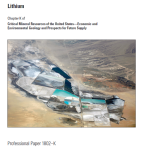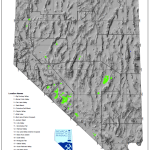Nevada Division of Minerals

Bond Pool Regulations in a Nutshell for Plans of Operation
Bond Pool regulations in a nutshell for plans of operation.
USGS Lithium Information
Lithium, the lightest of all metals, is used in air treatment, batteries, ceramics, glass, metallurgy, pharmaceuticals, and polymers. Rechargeable lithium-ion batteries are particularly important in efforts to reduce global warming because they make it possible to power cars and trucks from renewable sources of energy (for example, hydroelectric, solar, or wind) instead of by burning fossil fuels. Today, lithium is extracted from brines that are pumped from beneath arid sedimentary basins and extracted from granitic pegmatite ores. The leading producer of lithium from brine is Chile, and the leading producer of lithium from pegmatites is Australia. Other potential sources of lithium include clays, geothermal brines, oilfield brines, and zeolites. Worldwide resources of lithium are estimated to be more than 39 million metric tons, which is enough to meet projected demand to the year 2100. The United States is not a major producer at present but has significant lithium resources.
Lithium Brine Exploration Areas with Limitations Map
Map outlining Lithium Brine Exploration Areas in Nevada.
Mining Claim Filing Requirements in Nevada
An annual filing must be made for each lode or placer claim and each mill or tunnel site.
Nevada Mining Claim Procedures
Most Federal laws regarding mining on public land can be found in the United States Code (USC) under Title 30 “Mineral Lands and Mining” and Title 43, Chapter 35 “Federal Land Policy and Management” (FLPMA), and in the Code of Federal Regulations (CFR) under Title 43 “Public Lands.” The majority of Nevada state laws regarding mining can be found in the Nevada Revised Statutes (NRS) under Chapters 512 through 520 and several other chapters and in the Nevada Administrative Code (NAC) under Chapter 517. These laws were interpreted and refined through numerous court cases. Most of the statements below contain the more pertinent legal references, but a complete set of references for each regulation is beyond the scope of this publication. The law books, however, do contain exhaustive cross-references.
Distribution of Mining Claims Map
Distribution of Mining Claims in Nevada
LR 2000 Data as October 30, 2017
Hydrogeology of Clayton Valley Brine Deposits
Lithium brine is extracted from aquifers within the closed basin of Clayton Valley, located in the west central region of Nevada, approximately 50 miles east of the Sierra Nevada, within the Basin and Range province (fig. 1). Interest in potassium minerals led Leprechaun Mining and Chemical Inc., to many playas of the western United States. Chemical analysis of Clayton Valley sediments revealed abnormally high lithium, potassium, and sodium chloride concentrations.
In 1964, Foote Mineral Company acquired the mining rights and began in earnest the development of the playa system for the express purpose of producing lithium carbonate from brine. Production from the carbonate plant began in 1966. Initially, only a few production wells were constructed in the west central region of the playa. Target production was from a marker aquifer soon to be known as the Main Ash Aquifer. This aquifer, which occurs throughout the playa,
has been the largest and most productive horizon.
State and Federal Permits Required
This is a list of State and Federal permits and actions required during planning, development, construction, and before operation of Nevada mines and mills. We hope it will help both individuals and companies through the complex, often confusing regulatory maze - please understand that not all of these permits are necessarily required for all operations.
A Preliminary Deposit Model for Lithium Brines
This report is part of an effort by the U.S. Geological Survey to update existing mineral deposit models and to develop new ones. The global transition away from hydrocarbons toward energy alternatives increases demand for many scarce metals. Among these is lithium, a key component of lithium-ion batteries for electric and hybrid vehicles. Lithium (Li) brine deposits account for about three-fourths of the world’s lithium production (U.S. Geological Survey, 2011). Updating an earlier deposit model by Asher-Bolinder (1991), we emphasize geologic information that might directly or indirectly help in exploration for lithium brine deposits, or for assessing regions for mineral resource potential. Special attention is given to the best-known deposit in the world—Clayton Valley, Nevada (Kunasz, 1974; Davis and others, 1986; Price and others, 2000; Zampirro, 2004); Munk and others (2011a, b)—and to the giant Salar de Atacama, Chile (Risacher and others, 2003; Lowenstein and Risacher, 2009).


